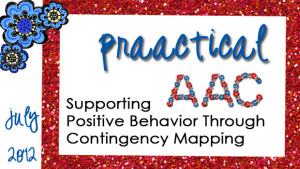November 26, 2013
by Carole Zangari -

Teaching language can be a sticky business. The concepts can be quite abstract, and that’s a challenge for many AAC learners. It can take some real thought to figure out how to simplify complexity. Beyond that, we have to teach in a way that helps learners retain the new information. Here are some of the things we think about when we’re running the our mental checklist of teaching options. 1. Graphic Organizers: There are so many ways to use graphic organizers to help simplify complex concepts. Use them to show relationships between things, sequences, and component parts. 2. Use a Story: Social narratives are somewhat like social stories, but don’t adhere to the same strict design parameters as a true social story. The TASN project in Kansas has almost 150 of them on a variety of topics on their website. You can check them out here. Most are in .doc,... [Read More...]
Filed under: PrAACtical Thinking
Tagged With: comprehension, contingency map, Graphic Organizers, social narrative, understanding
July 21, 2012
by Carole Zangari -

This month we’re focusing on visual supports and strategies to support positive behavior. We’ve talked about transition supports and environmental arrangements. Another way to help therapy sessions run smoothly and keep the focus on learning (rather than managing behavior) is to take proactive steps to make the expectations clear. For most people who are learning AAC, that means making sure there is a visual representation that accompanies the verbal explanation. – Many SLPs create a list of rules for expected behavior. In this post, we’ll talk about the research-supported strategy of using contingency maps. Contingency maps are a visual depiction that shows the desired behavior and the outcomes of two divergent paths: one where the learners engage in the desired behavior and the other that shows what happens if they don’t engage in the desired behavior. If you’re familiar with behavioral approaches, this strategy is right up your alley. The... [Read More...]
Filed under: Strategy of the Month
Tagged With: ASD, behavior, contingency map, developmental disability, intellectual disability, positive behavior support, visual supports

